Oil-based balms and butters are great for the skin, but they leave a trace of oil behind everywhere – you will discover oil stains on your pillow, smudges on the lens of your glasses and fingerprint evidence on everything you touch. If you are looking for a natural moisturiser recipe that is light and will absorb perfectly without leaving an oily residue on your skin, then this recipe is for you. The secret to making a lotion that absorbs perfectly is to combine oil with water – so this recipe is an emulsion. It requires a few more ingredients than balms and butters, but the method remains quick and easy. This recipe may also be used as a base which you can customise with your own essential oils.
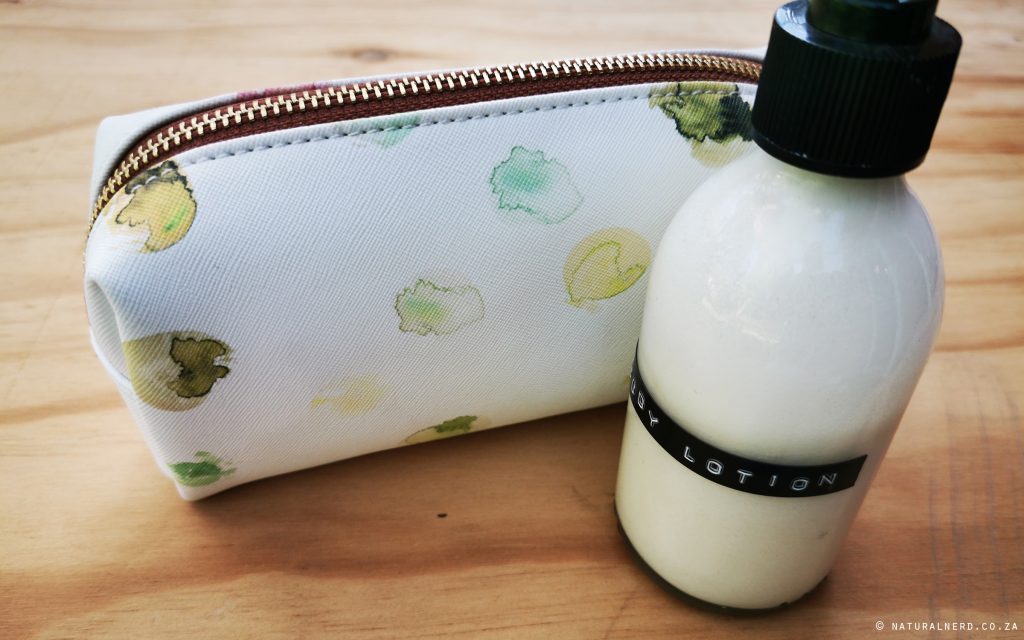
Lotion Emulsion for Beginners
Ingredients
Water Phase:
- 135g Distilled Water
- 2.5g Vegetable Glycerine
- 0.5g Xanthan Gum (about 1/8 teaspoon)
Oil Phase:
- 32g Olive Oil
- 12g Eco E-wax
- 8g Shea Butter
- 8g Coconut Oil
Cool Down Phase:
- 1g Geogard 221 or Euxyl K903 (preservative)
- 1g Citric Acid 25% Dilution (to correct pH)
Equipment & Tools:
- Scale (to weigh all ingredients)
- Blender or Whisk
- Graduated Pipette or Syringe (to dispense small volumes)
- 2x Heat-proof pots or beakers
- 2x Stainless steel spoons
- 2x Hot Plates / Stoves
- pH strips or digital pH meter (optional)
- Thermometer (optional)
- Sterilized container (to store lotion)
- Funnel (to transfer lotion into bottle)
Instructions
- Makes 200g lotion. This recipe must be followed in weight (grams).
- Prepare your station: First disinfect your working surface, equipment and packaging with min. 75% rubbing alcohol or bleach and allow to air dry.
- Combine vegetable glycerine with xanthan gum to make a paste. Set aside.
- Place all oil phase ingredients into one pot.
- Place the distilled water together into another pot.
- Start to heat the contents of both pots at exactly the same time, on the lowest heat setting.
- When the water becomes warm, add the glycerine-xanthan paste to the distilled water and mix well. The water will become murky and thicker, like a gel.
- Do not allow the ingredients in either pot to boil or get above 70’C. The contents should get hot, but not boiling hot. If you can’t get both pots to the same temperature, rather have the water phase hotter.
- Once the contents of both pots are the same hot temperature (approx. 70’C), combine them by adding the oil phase to the water phase (or vice versa).
- Whisk manually or blend until you see that the oil has combined with the water and the mixture is uniformly white and creamy. It should take about 5-10 minutes of manual whisking, or 30 seconds of blending. This is your lotion. It will still thicken more as it cools.
- Continue to manually stir until the lotion reaches trace (i.e. the stirring movement shows on the surface like footprints).
- Set your lotion aside to cool down to room temperature. Do not cover with a lid.
- Once the lotion has cooled down completely, add the citric acid dilution. Mix this in very well so that it is evenly distributed.
- Add the Geogard 221 preservative after you have mixed in the citric acid dilution. Ensure that you mix this in very well too, so that it is evenly distributed.
- Transfer your lotion into a sterilised container using a funnel if necessary, and store away from direct sunlight. Use within 3 months.
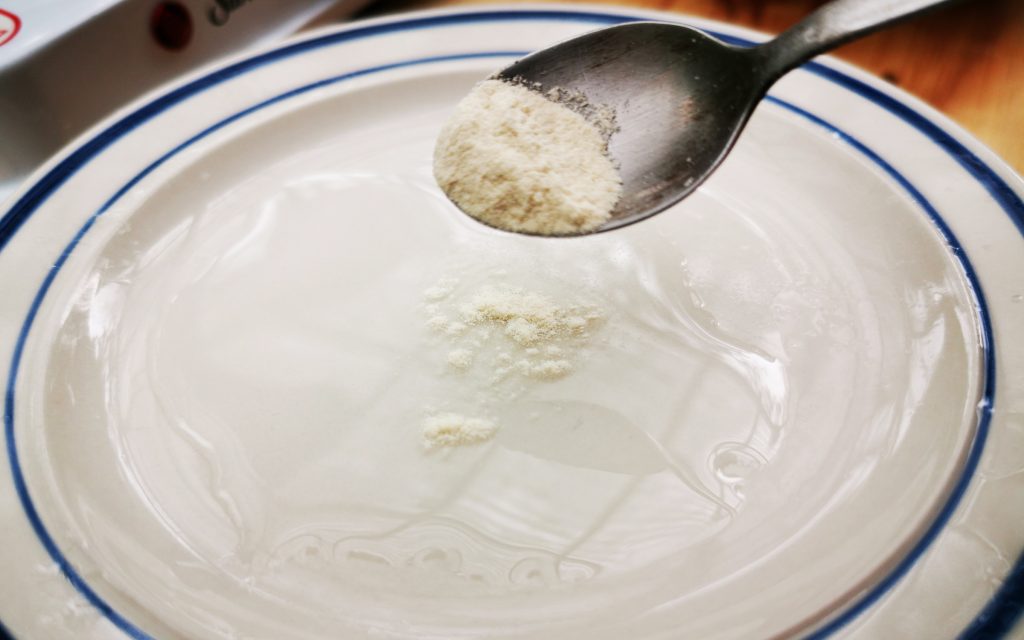
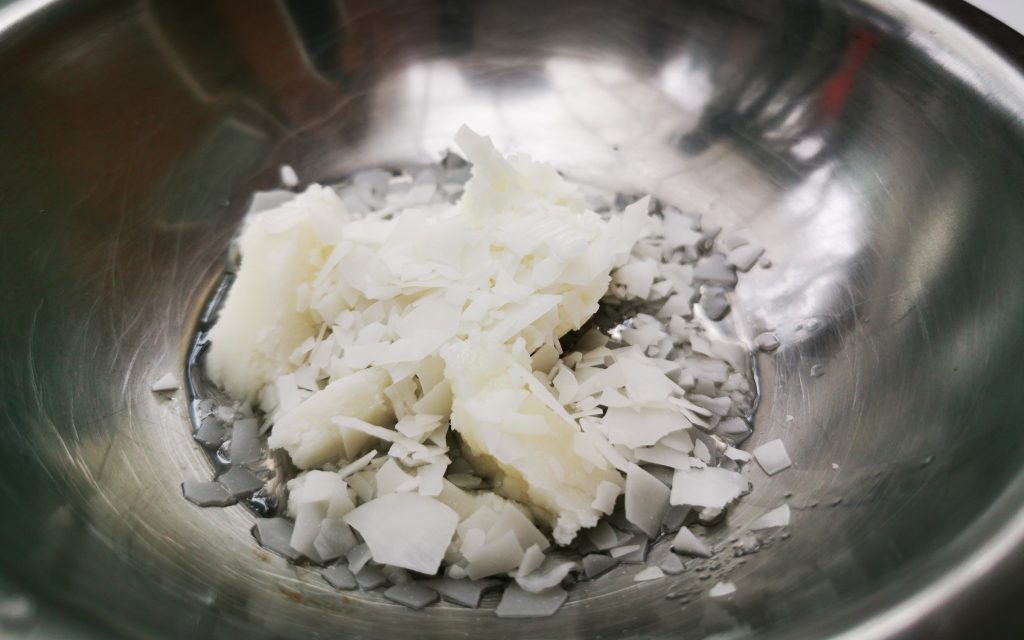
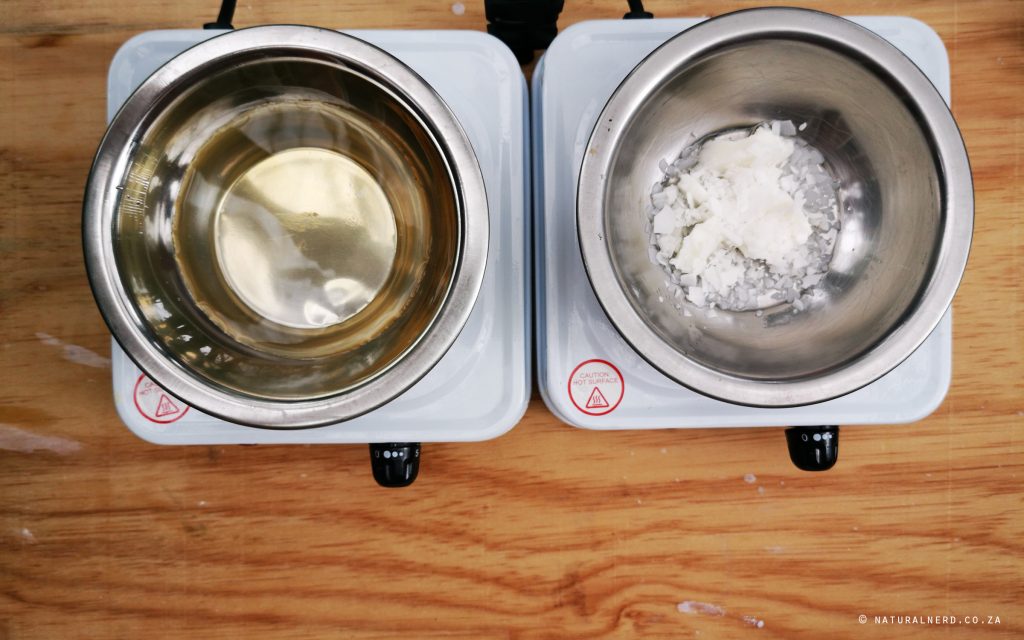
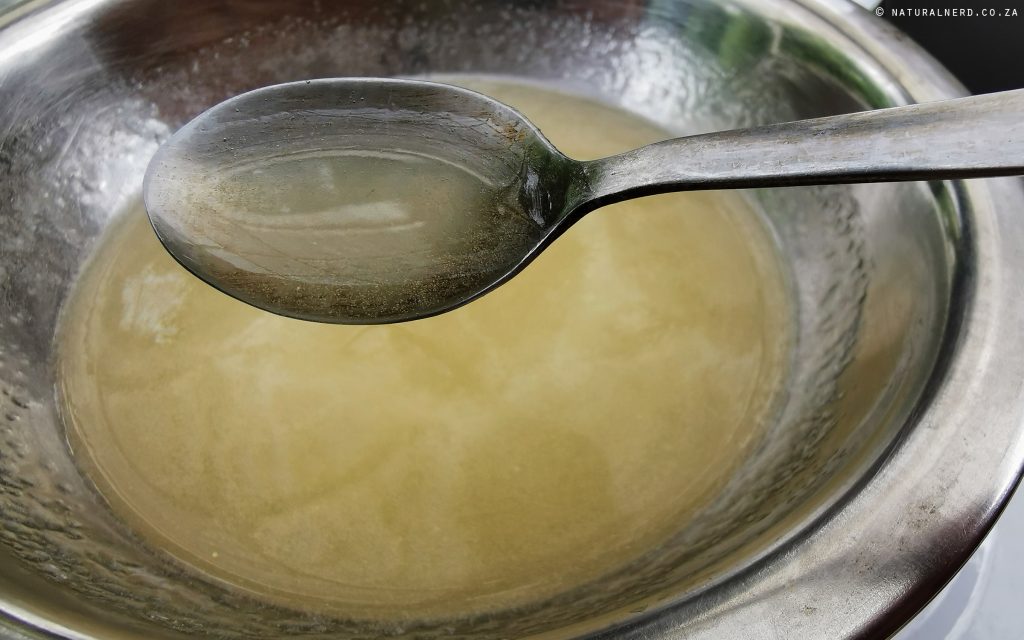
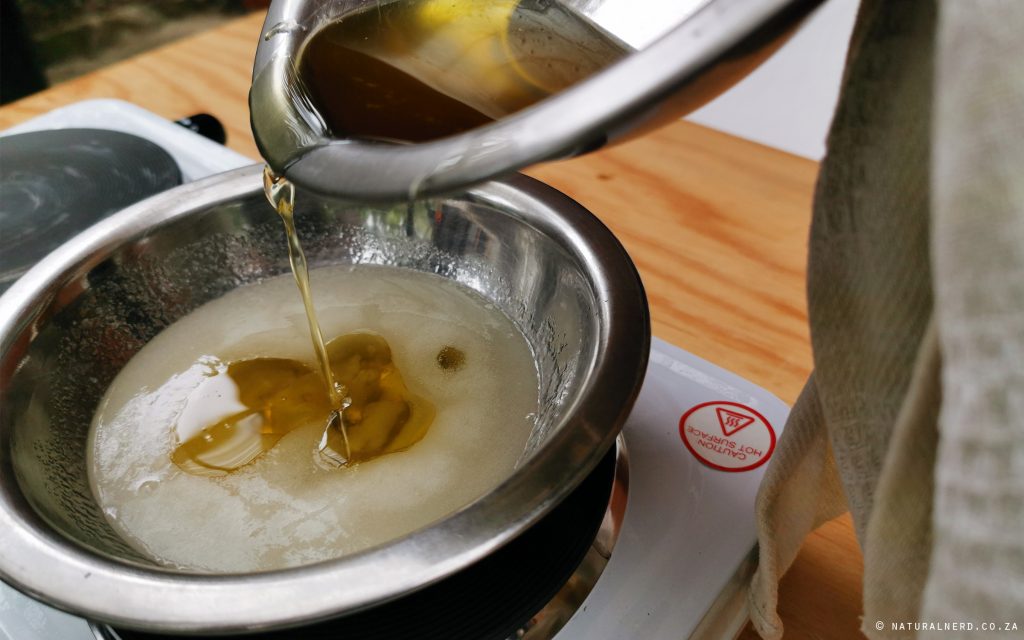
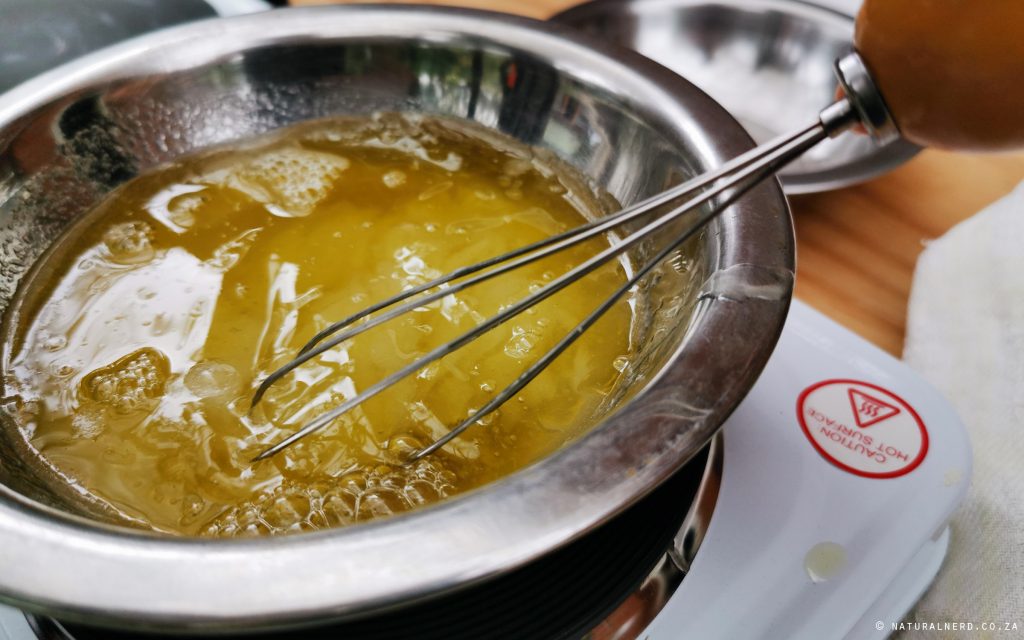
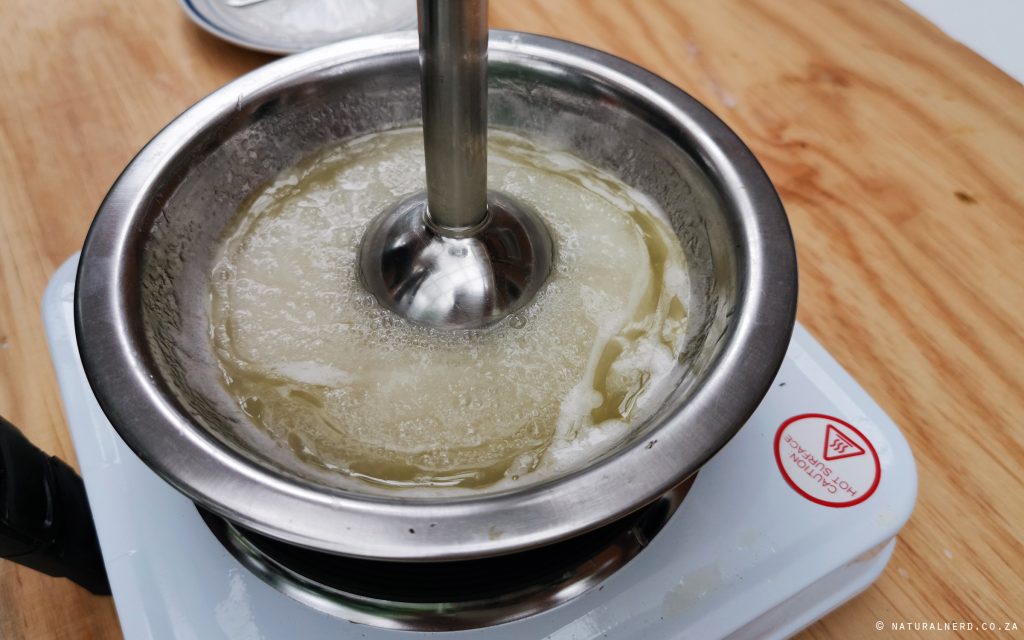
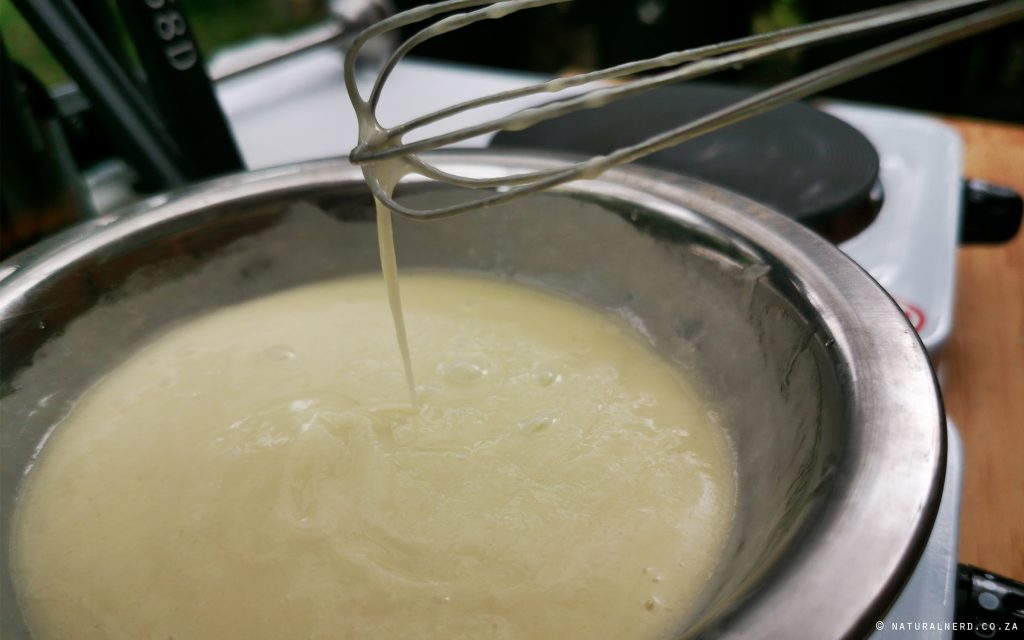
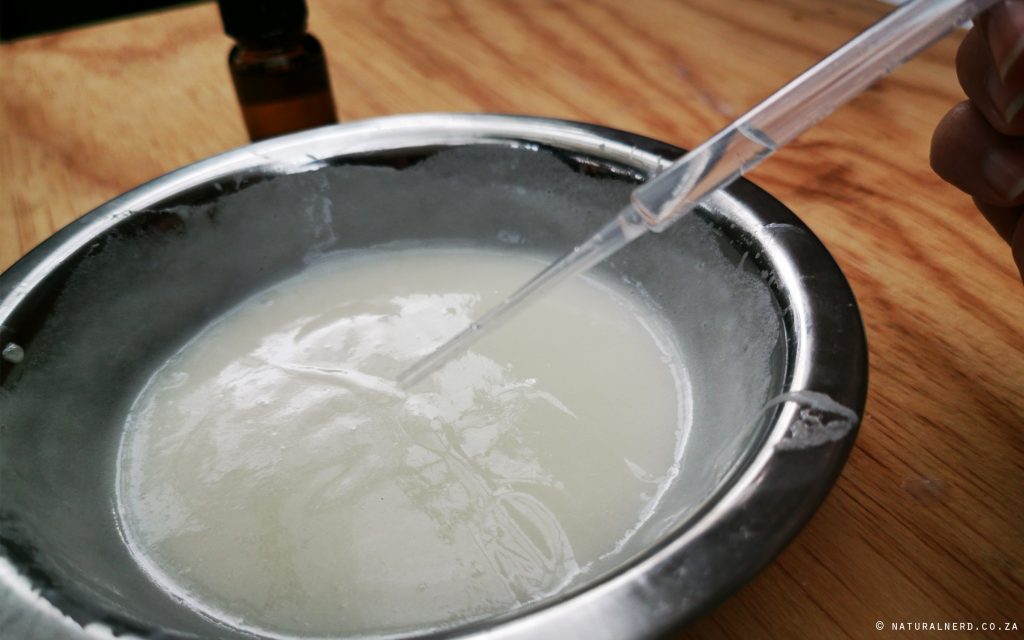
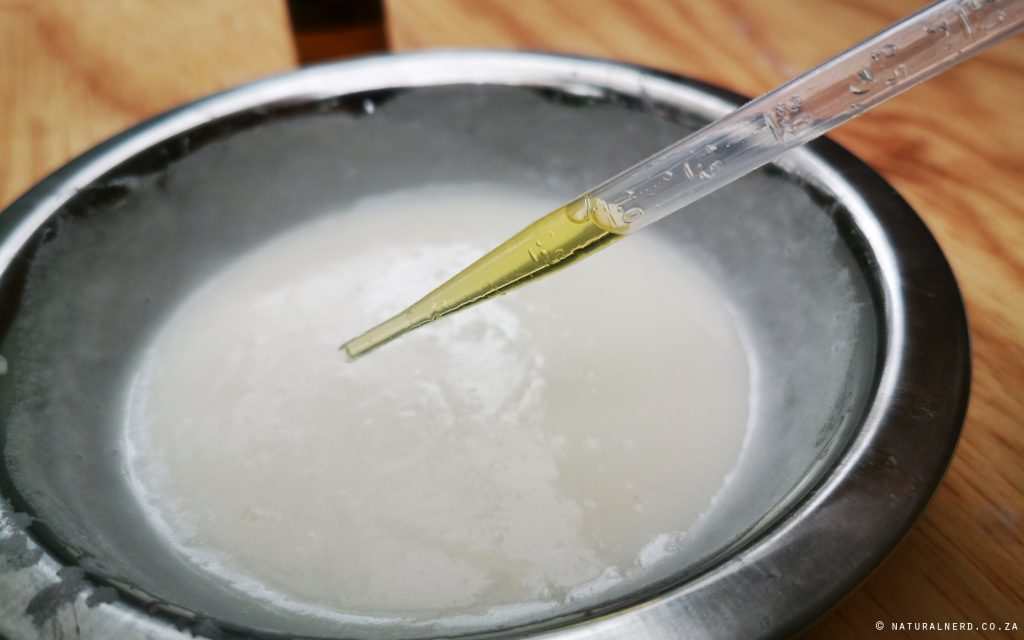
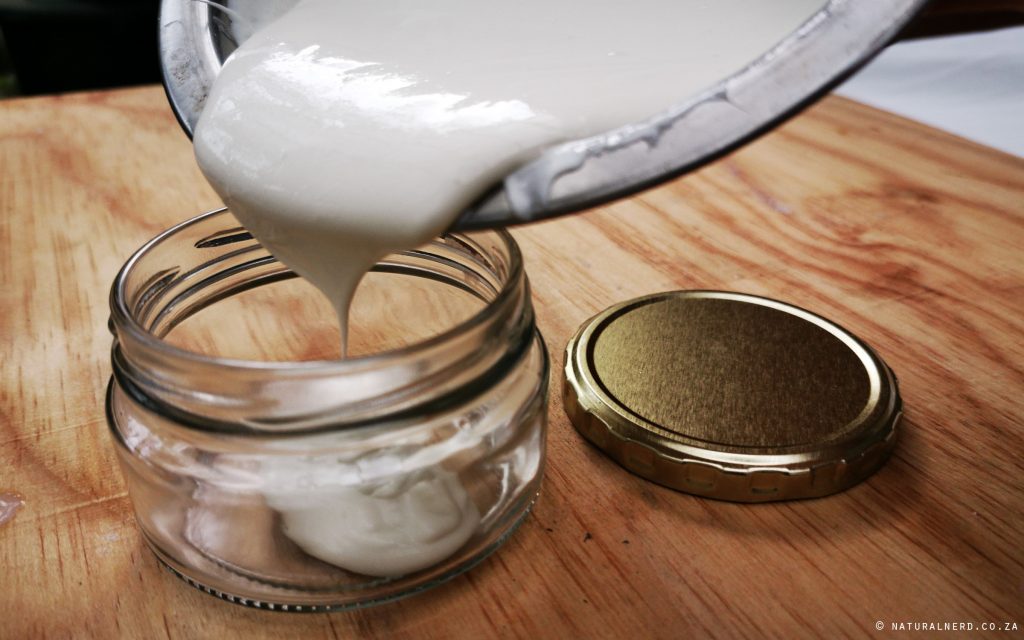
Notes
- The preservative is necessary, since there is water in this recipe. Water invites bacteria. Without the preservative, this lotion will have a maximum shelf life of one day even if it’s kept in the refrigerator. Without a preservative; dangerous bacteria, fungus, mould and yeast will start to grow. You may use any broad spectrum preservative, but bear in mind that each preservative has different applications and usage rates. So make sure to read the manufacturer’s directions and adjust the recipe accordingly.
- Caution: If you don’t have a high precision scale that can measure to two decimal places, please be cautious about measuring 1g of the preservative with a standard kitchen scale that can only read in 1g increments. It won’t be accurate. To confirm if your weight measurement is accurate, 1g of Geogard 221 is approximately 0.9ml in volume. Don’t rely on volume though. I’m merely mentioning the volume as a guideline to make sure that your weight is correct. If you try to weigh 1g on a kitchen scale, you’ll end up with way more than 0.9ml, which is dangerous.
- To make a 25% citric acid dilution, dissolve 1 part citric acid in 4 parts distilled water (in weight). In other words, 1 gram citric acid dissolved in 4 grams distilled water. For this recipe, you will use 1 ml of that final dilution. Or you can buy the ready-made solution here.
Recipe variations
Oil substitutes:
You may substitute the oils and butters in this recipe with any other oils and butters as long as you use the exact same weight. However, I cannot guarantee that it will have a texture, colour or scent that you like, since each oil brings different properties to lotions.
Adding essential oils:
You may add up to 5ml of additives to this lotion, for example, essential oils and vitamin E oil – or you may use this recipe as is for a fragrance-free lotion. I usually add about 2ml (~40 drops) of essential oils to my lotion base.
Changing quantities:
If you want to make a bigger batch, you may multiply the quantities. For example, multiply all ingredients by 5 to make one kilogram of lotion. This lotion is thin and light enough to be pumpable. If you would prefer a thicker, cream-like texture, adjust the quantities of these ingredients as follows: 115g distilled water; 16g Olive Oil; 20g Shea Butter; 30g Coconut Oil and 14g Eco E-wax. The same instructions apply. These quantities will result in a cream, rather than a lotion.
Citric acid:
You may choose to exclude the citric acid solution if your cream tests to at least a pH6. However, if it tests to pH8, like mine did, you must lower the pH in order for the preservative to work. Geogard 221 is only effective within pH 3-6 range. So, at pH8 you will have an unpreserved product. Citric acid solution is strongly recommended also because it lowers the pH of this lotion from pH8 (neutral) to pH5.5 (slightly acidic), which is the natural pH of our skin. You may also use your own pH strips / meter to measure the pH of your lotion, and add a few drops of citric acid at a time until you reach a pH5.5.
Note on preservatives:
When I make this recipe, I use the preservative Geogard 221. That’s why you’ll notice my photographs show me adding a liquid preservative at the end (in step 14). Euxyl K903 is essentially the same product as Geogard 221, and has the same usage rate and instructions. Like Geogard 221, it is also ECOCERT approved, and therefore it is the best substitute for Geogard 221.
You may use any broad spectrum cosmetic preservative you wish, but I recommend Geogard 221 or Geogard Ultra powder. Remember that each preservative has its own directions for use, so simply adjust the instructions in this post according to the manufacturers instructions. For example, if you use Geogard Ultra powder, you will need 1% which is 2g in this recipe. You should also add Geogard Ultra sooner – after step 11 when the lotion has reached trace, but it is still relatively warm. Also, Geogard Ultra will cause the pH of the lotion to be way too low, so you will need to use a 50% sodium bicarbonate solution to bring it up to pH 5.5 (instead of citric acid). This example illustrates how the recipe and method can change, when you change the preservative.
COST & SHELF LIFE
Cost Price: R18.70 per 200g (in 2019, based on the best retail prices I’ve found).
Lasted me about: 1 month using twice a day for my face and hands.
Estimated shelf life: 3 months if you include the preservative, and store away from direct sunlight. Without the preservative, this lotion only has a shelf life of 1 day when stored in the refrigerator. Please note that adding ingredients like vitamin E oil and anti-bacterial essential oils will not effectively preserve your product.
CHALLENGE
- If this is your first time making an emulsion, it may seem like you need a lot of ingredients that you’ve never heard of, especially when compared to making a simple oil-based moisturiser. You may be tempted to stick to the easy, greasy stuff.
- Some people may be weary about including a synthetic preservative. However, all preservatives are synthetic. The preservatives that I use are always ECOCERT and SOIL association approved to be used in certified organic products, and has no evidence of being toxic when used as instructed by the manufacturer (Geogard 221 at 0.5%, and Geogard Ultra at 1% of the total recipe weight).
CHERRY ON TOP
- No oily residue. Your skin will be moisturised without you having to look like a glazed donut.
- The texture of this emulsion is just like the lotions you buy in-store, except its completely natural. The texture is what you are most accustomed to.
- Works out significantly cheaper than any retail lotions and creams. And when you buy each ingredient, you will be able to make kilograms of lotion at a fraction of the cost of buying the same amount (whether natural or not). For example, the preservative Geogard 221 may cost you R200 to buy once-off, but since you are only using 1 gram at a time, you will be able to make this recipe 250 times over. That’s enough for 50 litres of lotion! It’s the same for other ingredients too. If you have to buy every ingredient, there will be an expensive once-off cost, but if you work it out you will see that the cost per gram of this recipe is cheap.
INGREDIENTS
- Distilled water: is a pure form of water without additional minerals, salts and other deposits which typically shorten the shelf life of a lotion. You can find distilled water at most pharmacies. Don’t confuse distilled water with filtered, spring or purified water – they are not the same thing. (Buy here)
- Vegetable glycerine: moisturises the skin and retains moisture in the skin by acting as a protective barrier that locks in moisture. It is also necessary to hydrate the xanthan gum in the recipe to prevent clumps from forming. (Buy here )
- Xanthan gum: stabalizes the lotion so that it does not separate or curdle in heat. Xanthan gum is a sugar derived from either corn, soy or wheat. (Buy here)
- Olive oil: contains anti-aging antioxidants and hydrating squalene, making it superb for hair, skin, and nails. (Buy here)
- Coconut oil: has anti-bacterial, anti-fungal and moisturizing properties. It is composed of nourishing fatty acids, especially high in lauric acid. It also contains vitamin E and healthy fats, which help to make skin smooth. (Buy here)
- Shea butter: has high concentrations of fatty acids and vitamins which soften skin. It also has anti-inflammatory properties. Shea butter conditions, tones, and soothes your skin. (Buy here)
- Eco E-wax: is a vegetable-based emulsifying wax which allows water and oil to combine without separating. It is also known as Glycerol Monostearate SE and is ECOCERT and SOIL association approved for use in natural and organic products. (Buy here)
- Geogard 221: is a synthetic preservative composed of benzyl alcohol and dehydroacetic acid as an amber liquid. It is ECOCERT, NATRUE and SOIL association approved for use in natural and organic products. (Buy here)
- Citric acid: is an organic acid that occurs naturally in citrus fruits and is a common additive in foods. In this recipe, citric acid is used to lower the pH of the neutral lotion to the natural pH of human skin, which is slightly acidic at pH 5.5. (Buy here)
Need help finding these, or other ingredients? My shopping guide may help you.
RECOMMENDED RETAIL OPTIONS
If you don’t want to make it yourself, then here are some natural lotion emulsion products which you can buy. I have used and approved each one. They are, however, more pricey than making it yourself:
My personal favorite (and it smells amazing!):
Earthsap Milk & Honey Lotion ingredients: Purified water, olive fruit oil, aloe oil, stearic acid (source: palm oil), beeswax, rosemary oil, vitamin E, xanthan gum, jojoba and evening primrose oil.
Best reviews and fragrance-free:
Oh Lief Natural Aqueous Cream ingredients: Water, glycerine, coconut oil, cetyl alcohol, sesame seed oil, olive fruit oil, glyceryl stearate, glyceryl stearate citrate, cetearyl alcohol, bentonite clay, betaine (sugar pulp), glyceryl caprylate, beeswax, xanthan gum, benzyl alcohol, dehydroacetic acid, citric acid, tocopherol (vitamin E).
Do you think that this is an effective lotion which absorbs perfectly? If you’ve tried it, please share your feedback in the comments below.

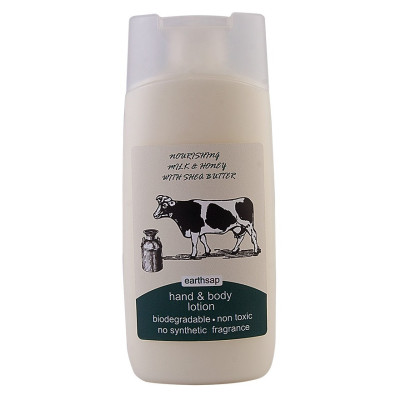

Hi Christine,
Thanks for the body lotion recipe. I tried it yesterday and it really is the best that I have tried so far (I have used the one on your course without the gum).
I find the ph strips a bit useless and see you link to the take-a-lot site – which do you recommend? I also need a more sensitive scale – mine only measures in 1g increments so I’m not 100 % sure I got the Glycerine and XGum measurements entirely correct.
Hi Lindsay,
Thank you so much for your positive feedback 🙂 I’m so happy that you like it. I’ve recently improved my course recipe to include the gum – it makes a huge difference. The reason I linked to a Takealot search, rather than a specific product, is because their links are constantly changing. But I personally buy the yellow one that currently costs between R244-R314. Here is the current link. I also only have a scale that measures in 1g increments – I’m sure your measurements were fine. It’s okay if they are off by a few milligrams. And with a bigger batch, you’ll be able to measure more accurately at least. But if you do want to buy a more sensitive scale, here is one that measures in 0.01g increments for sale on Takealot too. I hope that helps.
Hi Christina!
I am one of your student. I took your soap making classes & loved it. I really wish you could offer more courses for scrubs, creams etc. You are an excellent teacher.
I have a few questions for you, if you could answer them whenever you can….
1. Your ingredient list says vegetable glycerin. Does it matter if is not? Or is there a way I can find out if store bought glycerin is made from vegetables or not.
2. Can I make products to sell using your recipes?
Thanks & Take Care
Hello and welcome Rachna 🙂
It’s lovely to hear from you, and I’m glad you’re enjoying my blog. Thank you for your positive feedback on my Udemy soap course – that’s very encouraging to hear. Did you ever try adding aloe vera to your soap – how did it go? I am currently working on publishing my creams course. I meant to launch it last year, but I’ve had a tough year, so my plans haven’t worked out as I had hoped. I will launch that course next. Here are my answers to your questions:
(1) No, it doesn’t matter if it is not vegetable glycerine. I just specify this, because I know that many vegans use the recipes on my blog. So I always try to formulate plant-based recipes. You can use any type of glycerine. If the label doesn’t specify the word “vegetable”, then it is probably derived from animal fats instead of plant fats.
(2) Yes, you may make products using my recipes to sell. Thank you for asking.
Take care, and keep in touch. Wishing you all the best for your products.